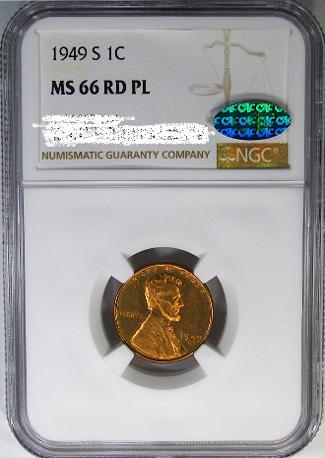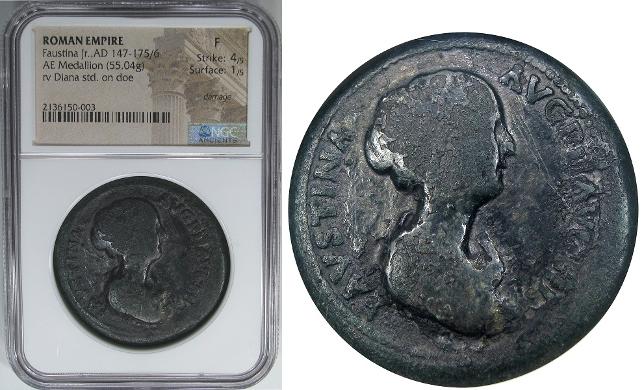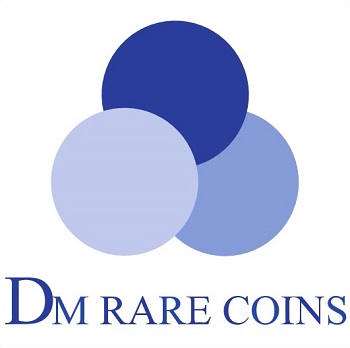Welcome to Our Blog!
Find useful information, announcements, coupons, anecdotes, market reports, an educational Coin of the Month, and musings not suitable for our Research section.
July 29, 2025
SINGLE FINEST KNOWN PROOFLIKE BRONZE CENT GRADED:
1864 TO 1982
1949-S LINCOLN WHEAT CENT
NGC / CAC
MS66 RD PL

Between 1864 and 1982, United States one cent coins were made of bronze. For whatever reason, cents in this metallic composition are rarely seen with Prooflike qualities. Compared to the rather common Prooflike 1943-S Steel cents, and the ubiquitous PL copper-plated zinc cents of the 1990s and onward, bronze PL coins are very rare.
It could be that this metal simply does not take well to reflective dies, or that it's prone to oxidation and older or darker PL coins don't show their mirrors well. Most PL cents are designated Red, Red Brown, or are Steel cents. Also, many PL coins are created by refurbishing a die that was damaged or worn during use; it may instead be that attention was rarely paid to quality control on the dies of minor denominations, and PL coins are scarce because few dies were pulled for polishing. I think it's a combination of all the above, but I also believe this last point holds the most weight, especially considering that most PL cents of the late 1920s through the mid-1950s happen to be refurbished dies, showing the familiar Granite-like texture of polishing, striations, mirrors, and Cameo.
In October of 2015, we wrote a blog post about the acquisition of the first-ever-graded Prooflike bronze Lincoln Memorial cent (that 1970-S happens to be an example of a PL from new dies). Since then, a handful of other PL cents have been found, including some Wheat cents, and there are two or three Prooflike bronze Indian cents on the books.
Of all the PL bronze cents struck between 1864 and 1982, there is just one coin in MS66RD PL, with none finer. It is this 1949-S NGC /CAC MS66 RD PL that crossed my desk recently. Second place is a 1908-S Indian cent in NGC MS65+ RD PL.
This 1949-S was struck from freshly polished, over-used dies, with the fields heavily polished to remove clashing and imperfections. It was so deeply basined that the edges of some of the design elements and lettering were lapped off, such as the back of Lincoln's neck, the coat fabric below his bow tie, and the upper right stand of the N in ONE. The dies were frosty from extensive use when Mint workers pulled them, and after the fields were polished to a reflective sheen, the devices maintained their frosty texture, creating a distinctive and very real, if accidental, Cameo appearance on both sides.
Because the fields of this piece are fully mirrored and it remains fully RED, its delicate but distinctively PL surfaces garnered the proper designation, and it got a CAC sticker on top of that, confirming its exceptional quality. This is something you justdon't see every day.
Happy Collecting!
Doug
DM Rare Coins
March 15, 2025
IDES OF MARCH
147-175/6AD Roman Empire "Medallion"
Faustina Jr. / Diana Standing on Doe, 55.04g Bronze

We don't like to miss the Ides of March, so what better time to resume our blog than today?
[Editor's Note: for about 9 years, we continued the Coin of the Month blog theme, but it came to be too cumbersome for three reasons. First, there was no flexibility in the format, and what was supposed to be fun and educational became nothing but a chore. Second, I refused to post anything that was currently up for sale because it was supposed to be strictly educational. This made it impossible to feature selected coins on a monthly basis because they were often still available. And then, when the blogs went up for sale, people wanted to know how to buy the coins! Our blogs are not advertisements. Finally, becoming editor of The MCA Advisory [the magazine of Medal Collectors of America] in 2023 took away much of the free time I had previously devoted to these concerns. Ultimately, I stopped posting.
Therefore, the new format will be to post whenever I have something interesting to share, regardless of interval or availability.]
Faustina Jr. was the daughter of Emperor Antoninus Pius and Faustina Senior. She and her husband, Emperor Marcus Aurelius, reigned from 161AD to 175 or 176 AD. She was given the honorary title of "Mother of the Camp" because she was beloved by the soldiers. That makes this ancient Roman medallion of Faustina Jr. all the more intriguing.
We usually think of the origins of modern medal-making having its roots in the Renaissance. However, it was actually the Romans who proliferated the art of ephemeral metallic propaganda, before it disappeared in the Dark Ages and Medieval period for 1000 years. Medals had no practical purpose or use, other than to commemorate an achievement, and surviving Roman medallions are exceptionally rare. Very thick and housed in a double-thick slab, and weighing over 55 grams, despite a roughly 38mm diameter. This much copper would be repurposed later, if it was not lost.
Hard surfaces despite considerable erosion, but a nice original river patina is quite desirable. Virtually all ancient Roman coinage is dug or otherwise recovered from the earth, and it is common for Roman issues to be found in water. A shiny, gunmetal blue and verdigris skin is typical of such objects. While some of these may have been lost during travels, often, shrines that required an offering were set up in rivers, and these objects were literally thrown into the water. This piece would be choice if not for some literally "ancient" scraping on the lower reverse. That said, anything materially better would be at least a thousand dollars more, and this is a handsome entry level piece. And where are you going to find another one? Definitely not here, this is not an advertisement! Get out your snorkel.
Editor's Note: It is popular to refer to Ancient Roman medals as "medallions." However, the technical definition of a medallion is a round disk of 100mm or more in diameter. Lesser pieces are (supposed to be) called medals, and under 20mm, medallets.
click to enlarge
Happy Collecting!
Doug
